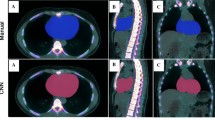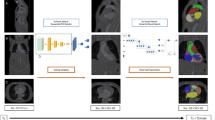Abstract
Background
We aimed to establish and test an automated AI-based method for rapid segmentation of the aortic wall in positron emission tomography/computed tomography (PET/CT) scans.
Methods
For segmentation of the wall in three sections: the arch, thoracic, and abdominal aorta, we developed a tool based on a convolutional neural network (CNN), available on the Research Consortium for Medical Image Analysis (RECOMIA) platform, capable of segmenting 100 different labels in CT images. It was tested on 18F-sodium fluoride PET/CT scans of 49 subjects (29 healthy controls and 20 angina pectoris patients) and compared to data obtained by manual segmentation. The following derived parameters were compared using Bland–Altman Limits of Agreement: segmented volume, and maximal, mean, and total standardized uptake values (SUVmax, SUVmean, SUVtotal). The repeatability of the manual method was examined in 25 randomly selected scans.
Results
CNN-derived values for volume, SUVmax, and SUVtotal were all slightly, i.e., 13-17%, lower than the corresponding manually obtained ones, whereas SUVmean values for the three aortic sections were virtually identical for the two methods. Manual segmentation lasted typically 1-2 hours per scan compared to about one minute with the CNN-based approach. The maximal deviation at repeat manual segmentation was 6%.
Conclusions
The automated CNN-based approach was much faster and provided parameters that were about 15% lower than the manually obtained values, except for SUVmean values, which were comparable. AI-based segmentation of the aorta already now appears as a trustworthy and fast alternative to slow and cumbersome manual segmentation.



Similar content being viewed by others
Abbreviations
- AI:
-
Artificial intelligence
- CNN:
-
Convolutional neural network
- CT:
-
Computed tomography
- NaF:
-
18F- sodium fluoride
- PET:
-
Positron emission tomography
- ROI:
-
Region of interest
- SUV:
-
Standardized uptake value
- VOI:
-
Volume of interest
References
Doherty TM, Asotra K, Fitzpatrick LA, Qiao J-H, Wilkin DJ, Detrano RC, et al. Calcification in atherosclerosis: Bone biology and chronic inflammation at the arterial crossroads. Proc Natl Acad Sci 2003;100:11201-6.
Tarkin JM, Dweck MR, Evans NR, Takx RA, Brown AJ, Tawakol A, et al. Imaging atherosclerosis. Circ Res 2016;118:750-69.
McKenney-Drake ML, Moghbel MC, Paydary K, Alloosh M, Houshmand S, Moe S, et al. 18 F-NaF and 18 F-FDG as molecular probes in the evaluation of atherosclerosis. Eur J Nucl Med Mol Imaging 2018;45:2190-200.
Libby P. The molecular mechanisms of the thrombotic complications of atherosclerosis. J Intern Med 2008;263:517-27.
Derlin T, Janssen T, Salamon J, Veldhoen S, Busch J, Schön G, et al. Age-related differences in the activity of arterial mineral deposition and regional bone metabolism: A 18 F-sodium fluoride positron emission tomography study. Osteoporos Int 2015;26:199-207.
Blomberg BA, de Jong PA, Thomassen A, Lam MG, Vach W, Olsen MH, et al. Thoracic aorta calcification but not inflammation is associated with increased cardiovascular disease risk: Results of the CAMONA study. Eur J Nucl Med Mol Imaging 2017;44:249-58.
Paydary K, Revheim M-E, Emamzadehfard S, Gholami S, Pourhassan S, Werner TJ et al. Quantitative thoracic aorta calcification assessment by 18F-NaF PET/CT and its correlation with atherosclerotic cardiovascular disorders and increasing age. Eur Radiol 2020.
Dou Q, Yu L, Chen H, Jin Y, Yang X, Qin J, et al. 3D deeply supervised network for automated segmentation of volumetric medical images. Med Image Anal 2017;41:40-54.
Lindgren Belal S, Sadik M, Kaboteh R, Enqvist O, Ulén J, Poulsen MH, et al. Deep learning for segmentation of 49 selected bones in CT scans: First step in automated PET/CT-based 3D quantification of skeletal metastases. Eur J Radiol 2019;113:89-95.
Mortensen MA, Borrelli P, Poulsen MH, Gerke O, Enqvist O, Ulén J, et al. Artificial intelligence-based versus manual assessment of prostate cancer in the prostate gland: A method comparison study. Clin Physiol Funct Imaging 2019;39:399-406.
Polymeri E, Sadik M, Kaboteh R, Borrelli P, Enqvist O, Ulén J, et al. Deep learning-based quantification of PET/CT prostate gland uptake: Association with overall survival. Clin Physiol Funct Imaging 2020;40:106-13.
Blomberg BA, Thomassen A, Takx RA, Vilstrup MH, Hess S, Nielsen AL, et al. Delayed sodium 18F-fluoride PET/CT imaging does not improve quantification of vascular calcification metabolism: Results from the CAMONA study. J Nucl Cardiol 2014;21:293-304.
Trägårdh E, Borrelli P, Kaboteh R, Gillberg T, Ulén J, Enqvist O, et al. RECOMIA: A cloud-based platform for artificial intelligence research in nuclear medicine and radiology. EJNMMI Phys 2020;7:1-12.
Ronneberger O, Fischer P, Brox T. U-net: Convolutional networks for biomedical image segmentation. International Conference on Medical image computing and computer-assisted intervention; 2015. p. 234-41.
Kingma DP, Ba J. Adam: A method for stochastic optimization. arXiv preprint arXiv:14126980 2014.
Carkeet A. Exact parametric confidence intervals for Bland-Altman limits of agreement. Optom Vis Sci 2015;92:e71-80.
Gerke O. Reporting standards for a Bland-Altman agreement analysis: A review of methodological reviews. Diagnostics 2020;10:334.
Høilund-Carlsen PF, Edenbrandt L, Alavi A. Global disease score (GDS) is the name of the game! Eur J Nucl Med Mol Imaging 2019;46:1768-72.
Høilund-Carlsen PF, Sturek M, Alavi A, Gerke O. Atherosclerosis imaging with 18F-sodium fluoride PET: State-of-the-art review. Eur J Nucl Med Mol Imaging 2020;47:1538-51.
Kinahan PE, Fletcher JW. Positron emission tomography-computed tomography standardized uptake values in clinical practice and assessing response to therapy. Seminars in Ultrasound, CT and MRI 2010;31:496-505.
Natsis KI, Tsitouridis IA, Didagelos MV, Fillipidis AA, Vlasis KG, Tsikaras PD. Anatomical variations in the branches of the human aortic arch in 633 angiographies: Clinical significance and literature review. Surg Radiol Anat 2009;31:319.
Høilund-Carlsen P, Lauritzen S, Marving J, Rasmussen S, Hesse B, Folke K, et al. The reliability of measuring left ventricular ejection fraction by radionuclide cardiography: Evaluation by the method of variance components. Heart 1988;59:653-62.
Arbab-Zadeh A, Fuster V. The myth of the “vulnerable plaque”. J Am Coll Cardiol 2015;65:846.
Duquette AA, Jodoin P-M, Bouchot O, Lalande A. 3D segmentation of abdominal aorta from CT-scan and MR images. Comput Med Imaging Graph 2012;36:294-303.
Xie Y, Padgett J, Biancardi AM, Reeves AP. Automated aorta segmentation in low-dose chest CT images. Int J Comput Assist Radiol Surg 2014;9:211-9.
Disclosures
None declared.
Funding
The study was partly funded through a PhD scholarship to Reza Piri by the University of Southern Denmark, Odense, Denmark.
Author information
Authors and Affiliations
Corresponding author
Additional information
Publisher's Note
Springer Nature remains neutral with regard to jurisdictional claims in published maps and institutional affiliations.
The authors of this article have provided a PowerPoint file, available for download at SpringerLink, which summarises the contents of the paper and is free for re-use at meetings and presentations. Search for the article DOI on SpringerLink.com.
The authors have also provided an audio summary of the article, which is available to download as ESM, or to listen to via the JNC/ASNC Podcast.
Supplementary Information
Below is the link to the electronic supplementary material.
Rights and permissions
About this article
Cite this article
Piri, R., Edenbrandt, L., Larsson, M. et al. Aortic wall segmentation in 18F-sodium fluoride PET/CT scans: Head-to-head comparison of artificial intelligence-based versus manual segmentation. J. Nucl. Cardiol. 29, 2001–2010 (2022). https://doi.org/10.1007/s12350-021-02649-z
Received:
Accepted:
Published:
Issue Date:
DOI: https://doi.org/10.1007/s12350-021-02649-z




